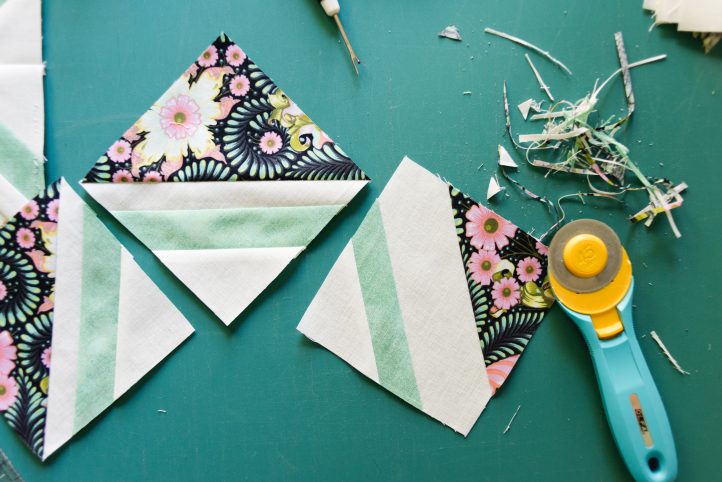
We’ve all heard the cardinal rules of cutting fabric. “Don’t use your fabric scissors to cut paper!” “Always make sure your fabric is flat before cutting!” “Cut on the grain!” But have you ever thought about just how many different types of cutting tools exist? Basic fabric scissors (or fabric shears) are fine for beginner projects but when you begin moving on to more complicated projects and specialty fabrics, you start to realize that there are a wide range of cutting tools available.
If you aren’t sure what to use pinking shears for or when you should use a rotary cutter, let us help you with this quick guide to cutting tools! We’ll cover the basic cutting tools that sewists and quilters are most likely to encounter, as well as some specialty tools you can find online or at your local fabric store. Take the stress out of snipping and stitching with our helpful guide. Be sure to favorite this article so that you always have it on hand when you need it.
Basic Cutting Tools for Sewing
- Fabric Shears – As mentioned earlier, all sewists need a good basic pair of fabric scissors or fabric shears. These can be found online and in all fabric stores and are also known as dressmaking shears. According to an article on Bernina’s website (“Basic Sewing Tools for Beginners”, WeAllSew.com), “The longer the blade, the more fabric can be cut with a single cutting stroke, so choose the longest blade that fits most comfortably in your hand”. You should always keep the blades of your shears sharp and store them away safely when not in use.
- Seam Ripper – Another tool that all sewists need, seam rippers allow you to easily remove stitches by cutting through your thread. Seam rippers feature a sharp, small blade on one end of its ‘U’ shape and a ball on the other; this ball protects your fabric when ripping out a seam. You can find seam rippers in fabric stores, as well as some emergency sewing kits for quick fixes.
- Craft Scissors – Not to be used on fabric, it’s always good to have a set of craft scissors on hand, for both cutting out paper patterns and non-traditional materials (non-fabric) that you may use in your projects. These are available at most retailers.
- Angled Fabric Scissors – Similar to normal fabric shears, these angled scissors are also designed to cut fabric and are great for long and straight cutting.
- Pinking Shears – Pinking shears look similar to fabric scissors but featured a zigzag pattern on their blades. Pinking shears are typically used to finish fabrics and trim seam allowances. This cutting tool is best for light to medium-weight fabrics.
- Heavy Duty Fabric Scissors – This cutting tool is for heavy weight fabrics, such as fabric for a winter coat, as normal fabric shears may not be able to handle cutting heavy fabric evenly.
Basic Cutting Tools for Quilting
- Rotary Cutter – The most essential of quilting tools, a rotary cutter allows you to cut through fabric smoothly with sharp and accurate cuts. Often used in tandem with a cutting mat and quilting ruler, rotary cutters are available in different blade sizes and should be stored away safely when not in use. It’s very important to keep your rotary cutter blades sharp, and sharpening tools are available online.
- Batting Shears – Batting shears are used to cut batting, which is part of the essential quilt sandwich. They resemble angled fabric scissors and are available online and in quilting supply stores.
- Thread Snipping Tools – Handy for both sewing and quilting, these small snipping tools are used to trim threads, snip in tight spots and give your projects a professional finish.
Specialty Cutting Tools
- Embroidery Scissors – Designed for snipping embroidery floss, embroidery scissors are small and can be ornately designed. They can also be used for making other small cuts while sewing and are very sharp. There are different types of embroidery scissors out there, so be sure to research what type of scissors you need for your embroidery projects.
- Fabric Cutting Machines/Die Cutters – Available from companies like Cricut, these die cutting tools are great for fabric applique projects and can be used on a variety of different fabrics and materials, including leather.
- Applique Scissors – Also known as duckbill scissors, these scissors are designed for applique projects as well as cutting extra fabric and trimming seam allowances.
- Buttonhole Cutter – Buttonhole cutters are used to precisely cut open the holes on buttonholes and are handy tools to use during the garment making process.
While this list is by no means definitive, it covers the basic tools that sewists and quilters will use regularly. We hope you’ve found our quick guide to cutting tools helpful! What types of cutting tools do you use? Where do you like to buy your sewing and quilting tools? Share your favorites below in the comments!
